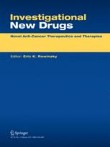
Medicine RSS-Feeds by Alexandros G. Sfakianakis,Anapafseos 5 Agios Nikolaos 72100 Crete Greece,00302841026182,00306932607174,alsfakia@gmail.com
Πληροφορίες
Πέμπτη 15 Οκτωβρίου 2020
Recombinant human lactoferrin carrying humanized glycosylation exhibits antileukemia selective cytotoxicity, microfilament disruption, cell cycle arrest, and apoptosis activities
Recombinant human lactoferrin carrying humanized glycosylation exhibits antileukemia selective cytotoxicity, microfilament disruption, cell cycle arrest, and apoptosis activities:


Εγγραφή σε:
Σχόλια ανάρτησης (Atom)
Αρχειοθήκη ιστολογίου
-
►
2023
(366)
- ► Φεβρουαρίου (184)
- ► Ιανουαρίου (182)
-
►
2022
(2814)
- ► Δεκεμβρίου (182)
- ► Σεπτεμβρίου (213)
- ► Φεβρουαρίου (264)
- ► Ιανουαρίου (262)
-
►
2021
(3815)
- ► Δεκεμβρίου (229)
- ► Σεπτεμβρίου (276)
- ► Φεβρουαρίου (64)
-
▼
2020
(5754)
- ► Δεκεμβρίου (401)
-
▼
Οκτωβρίου
(186)
-
▼
Οκτ 15
(98)
- Role of Pharmacists in Hormonal Contraceptive Access
- Cystocele Repair by a Modified Surgical Technique ...
- Detection of Usutu virus infection in wild birds
- Detection and discrimination of influenza B Victor...
- Neisseria gonorrhoeae isolates
- Short-term outcomes after a neonatal arterial isch...
- Down–regulating miR-217-5p Protects Cardiomyocytes...
- Age- and movement-related modulation of cortical o...
- Sialic acids expression in newborn rat lungs: impl...
- Penetrating Midface Trauma
- Leukocyte and platelet-rich fibrin have same effec...
- Permanent iodine-125 implantation with or without ...
- Radiotherapy or brachytherapy after resection of p...
- Identification of male infertility-related long no...
- Spontaneous remission of untreated primary amyloid...
- Post‐herpetic neuralgia
- Atypical Bilateral Multifocal Congenital Toxoplasm...
- Massive Upper Gastrointestinal Bleeding Following ...
- Subacute Aspergillosis “Fungal Balls”
- Eosinophilic Myocarditis
- Oxygen therapy strategies and techniques to treat ...
- Conventionally Versus Digitally Fabricated Denture
- Lectin Drug Conjugate Therapy for Colorectal Cancer
- What causes hidradenitis suppurativa ?
- Genome‐wide association analysis of psoriasis pati...
- An active endoscope with small sweep volume that p...
- Emergency Airway Management During Awake Craniotomy
- Electroencephalographic Alpha and Delta Oscillatio...
- Role of Dexmedetomidine in Aneurysmal Subarachnoid...
- A Curious Case of Persistent Throat Pain......a ma...
- Aerosol Transmission of Infectious Agents During M...
- Facial Nerve Intraneural Perineurioma
- a man in his 20s who presented with a 4-week histo...
- Eustachian Tube Rhabdomyomatous Mesenchymal Hamart...
- Predictors of OSA following Adenotonsillectomy in ...
- Evaluation of cerebral arteriovenous shunts
- Activation of 5‐HT7 receptor but not NOS is necess...
- Sleep restriction alters physiological and emotion...
- The acute effect of resistance exercise on limb bl...
- Optimising sleep and performance during night float
- Intestinal obstruction secondary to shiitake mushr...
- Ankylosis of the temporomandibular joint
- Effect of chitosan solutions with or without fluor...
- Rosai‐Dorfman disease of the pancreas
- Epilepsy and movement disorders in Congenital glyc...
- Novel GLI3 pathogenic variants in complex pre‐ and...
- Multiple Cranial Neuropathies as the Presenting Si...
- RT-qPCR versus Digital PCR: How Do They Impact Dif...
- Acquired Pure Red Cell Aplasia Associated with Chr...
- Microsatellite-Stable Radiation-Induced Angiosarco...
- physical activity (PA) and sedentary time (ST) wit...
- Association among serum and salivary A. actinomyce...
- Rates of lymphocytic thyroiditis and ultrasound fe...
- The ketogenic diet corrects metabolic hypogonadism...
- The effect of dual-release versus conventional hyd...
- Trichomegaly Associated with Panitumumab
- Vancomycin-Induced Linear IgA Bullous Dermatosis
- Lymphocyte Variant Hypereosinophilic Syndrome With...
- Mural Intracholecystic Neoplasms Arising in Adenom...
- CT and FDG-PET radiologic biomarkers in p16+ oroph...
- Intrathoracic migration of ventriculo-peritoneal s...
- Application of 4D-CT Scanning in Differential Diag...
- Saponin from Periploca forrestii Schltr Mitigates ...
- Canakinumab in Patients with Adult-Onset Still’s D...
- Surgical clip occlusion of the V3 segment to preve...
- Successful non-operative management for atlanto-oc...
- Biopsychosocial variations in quality of life outc...
- Primary Ewing’s sarcoma of the C2 vertebra with pr...
- Prevalence of intracranial aneurysms among acute i...
- Histopathological variation in the demyelinating s...
- Surgical management of vertebral metastatic gastro...
- Radionuclide tumor necrosis factor-alpha activity ...
- Successful mechanical thrombectomy using a combine...
- Endoscopic-assisted paramedian infratentorial supr...
- The Latest on Uveal Melanoma Research and Clinical...
- Hypo-fractionated FLASH-RT as an effective treatme...
- Comparison of Dynamic Contrast-Enhancement Paramet...
- Centrally Reduced Diffusion Sign for Differentiati...
- Location-Specific ASPECTS Paradigm in Acute Ischem...
- Image-Guided Biopsies in the Head and Neck
- MRI-Based Assessment of the Pharyngeal Constrictor...
- 125I seeds irradiation inhibits tumor growth and i...
- Cranial Nerve III Palsy in the setting of COVID 19...
- TAM family receptors in conjunction with MAPK sign...
- 5-methyltetrahydrofolate-based radioconjugates—new...
- Recombinant human lactoferrin carrying humanized g...
- Donafenib in Progressive Locally Advanced or Metas...
- Transcription Factor Profiling Identifies Spatiall...
- Differential effects of GABA A receptor activation...
- Urothelial toxicity of esketamine in the treatment...
- ScienceDirect Publication: Talanta
- Brachytherapy
- Climate change likely dr
- bioRxiv Subject Collection: Evolutionary Biology
- Nanomaterials<
- International Journal of Molecular Sciences
- International Journal of Environmental Research ...
- Antibiotics
-
▼
Οκτ 15
(98)
- ► Σεπτεμβρίου (365)
- ► Φεβρουαρίου (754)
- ► Ιανουαρίου (894)
-
►
2019
(146)
- ► Δεκεμβρίου (19)
- ► Σεπτεμβρίου (54)

Δεν υπάρχουν σχόλια:
Δημοσίευση σχολίου